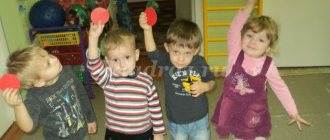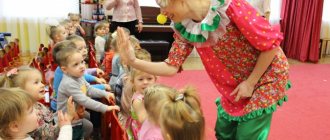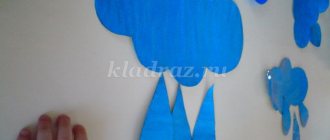Construction and constructive games, educational and methodological material on construction, manual labor
- Characteristics of construction games.
In the history of pedagogy, games with building materials have been described for a long time and are represented in many systems of educating preschoolers. This type of game has been studied quite well in domestic preschool pedagogy (A.N. Davidchuk, L.A. Wenger, L.A. Paramonova, S.V. Petrushina, etc.).
The peculiarity of games with building materials is that they are based on building skills and abilities, as a result of which, to a greater extent than any other type of children's game, they are closer to the creative and productive activity of a person. Constructive construction games promote the development of thinking and spatial imagination, which are the basis of design activity, as convincingly demonstrated in the studies of N. N. Poddyakov, L. A. Paramonov and others.
In the process of constructive construction games, the teacher teaches children to observe, distinguish, compare, remember and reproduce construction techniques, and focus on the sequence of actions. Children study the construction diagram of a building, learn to plan the work, presenting it as a whole, analyze and synthesize the building, and show imagination.
The content of games with building materials is the creation and reproduction of the surrounding reality using various materials.
The following types of building materials are distinguished:
– specially created (floor, tabletop building material, “Old Castle” type set, “Young Architect” type set, construction set);
-natural (sand, snow, stones, clay);
– stand (cards, boxes, boxes, etc.).
Games with building materials are associated with other types of games (role-playing, theatrical, mobile, didactic).
The presence of the concept of the game, its free development, the variability of the solution - all this determines the creative nature of games with building materials.
one
Construction.
Construction (from the Latin construo - to build, create) means construction as a whole, bringing various objects, parts, elements into a certain relative position and the process of creating a model, machine, structure, technology with drawings and calculations.
Children's design refers to the process of constructing buildings, such structures that provide for the relative arrangement of parts and elements, and methods for connecting them. As a rule, the design process takes place in a playful way to interest the preschooler.
In theory and practice, there are several types of structures:
- Pattern design is the most common type of design. It has many positive aspects: children develop various skills, master general techniques, and learn sequences of actions.
- Designing on a specific topic brings the child closer to the creative implementation of a task, but on a limited topic.
- Designing according to your own project is a complex type of design in which the child independently solves all problems, sets the goal of the activity, plans it, collects material and implements the concept.
- Conditional design: contains great opportunities for development. The child independently determines the length and height of the building.
- A model building is a type of construction developed by A. R. Luria. The child is offered a model of the building (a drawing made by the building teacher, pasted over with paper), on which the outlines of the constituent elements of the structure are hidden (model of a sofa, gate, car).
Each of the considered types of construction has its own advantages, because it is necessary to combine them in educational work, in childhood in a preschool institution.
Of all the variety of construction sets that are used in preschool institutions, I would like to focus on LEGO
2
construction set, which is “a bright, colorful and multifunctional material that opens up enormous opportunities for a child’s research and experimental activities.” With its help, you can solve complex problems through an exciting, creative game in which there will be no losers, because any child can handle it. The elements of the LEGO set have different sizes, different shapes, and simple options for attaching to other elements.
LEGO - the designer is widely used in design classes and solves the following problems: develops mental processes (analysis, synthesis, comparison, generalization, etc.). A fairly effective means of improving thinking is to design using models, diagrams, drawings, plans, samples, and from memory.
LEGO - the constructor is also used in mathematics lessons to consolidate and develop the skills of forward and backward counting, comparing numbers, knowledge of the composition of numbers, geometric shapes; the ability to navigate an airplane, the ability to classify by characteristics.
In lessons on familiarization with the environment, LEGO is used in experimental activities as the material from which the construction set is made (“What is it made of?”, “Find the same thing,” “How are they similar and how are they different?”).
With the help of LEGO, children pass on their acquired knowledge and impressions from lessons, excursions, observations and walks through buildings.
LEGO is a powerful source of developing children's interest in construction.
- Conditions for the development of games with building and natural materials.
To develop children’s play activity, it is necessary to create the following conditions:
- Organize the play environment: select the necessary building material in accordance with the objectives of developmental construction activities in the preschool institution. The material should be varied (floor, tabletop, different types of builders,
3
set and so on), beautifully designed, stable enough to suit children's abilities.
- Find time and space to play with building materials. Games require concentration of thought and attention. Therefore, play stands with tabletop building materials and construction materials must be placed so that they do not interfere with children or distract them.
- Respect for buildings and structures made by children. Usually the child likes to “return” to his buildings and make changes. Therefore, it is necessary to instill in all children a careful and attentive attitude towards their own buildings and the buildings of others.
- To create conditions for playing with buildings for this, you should choose small toys (cars, trains, figures of people and animals, etc.).
- Combine children for cooperative constructions from the builder. Create a situation in which a child who has acquired new construction skills will teach them to other children.
- Teach children to handle building materials carefully. Carefully disassemble the building, the craft from the designer, arrange the parts and shapes in the cells of the rack, drawers.
What else to read: What to do with a child? 13 games on a piece of paper: with words and pictures
Games with natural materials.
These games enter a child's life early. Just having learned to walk, the child takes a shovel, a spade, tries to dig snow, sand, and loves to play with water. But without special training, children do not acquire the necessary skills, and games with natural materials are monotonous and lack content.
Meanwhile, they contain great opportunities for the development of children's thinking, will and perseverance.
These possibilities are largely determined by the nature of the natural material. It is very diverse and has different properties that dictate different ways of using it as a building material.
The child learns many properties of natural materials through the senses. Methods of sensory cognition, the ability to highlight certain properties and qualities of objects are developed in the process of meaning
4
interesting activity, especially in the game.
Games with natural materials - snow, water, sand, clay, grass, sticks, shells, pine cones, chestnuts, acorns, rose hips, maple seeds, linden, thorns, leaves, roots, bark, moss, etc. – excellent raw materials for crafts and games with them.
Every year modern pedagogy masters an increasing number of different methods and directions.
The pedagogical sandbox is a good environment for individual and group work with children for the purpose of their spiritual and moral development, personal development and cultural growth.
Sandplay cannot be interpreted. The teacher must play the role of an attentive spectator. The position of the teacher is “active presence”; she does not lead the process. The release of stored energy leads to its transformation, which allows you to direct the converted energy to personal development and further learning.
The main tasks of the pedagogical sandbox:
– Child’s self-development through creative games in the sand.
– Development of tactile-kinesthetic sensitivity and fine motor skills of the hands.
– Strengthen the skills of phonetic and grammatical structure, sound pronunciation, teaching literacy and writing.
– Development of a creative personality.
- Guidance of building and construction games in different age groups.
The teacher performs the following tasks:
– expand children’s understanding and draw their attention to the work of builders and the equipment they use; – methods of teaching the construction, education and development of independence and mental activity, constructive and creative abilities; – formation of hard work, development of correct relationships between children, uniting them into a friendly team.
First junior group
The kindergarten program for younger groups includes construction games with toys, design lessons
5
material on which the necessary actions are taught, the formation of simple, but understandable and lasting skills. Children are introduced to building materials, their shape, size, different locations on the table top (beds, supports); learn to lay one on top of the other, lay bricks horizontally (train, track); form the simplest ceiling (gate, house). The teacher finds similarities between familiar buildings and objects of surrounding life.
Second junior group
They are taught not only to distinguish the main parts of the building (cube, brick, slab), but also to give them names, and also to place bricks at equal distances from each other in a circle, in a quadrangle (fence, fence), placing them on a smaller plane . Already at this age, children are taught to purposefully inspect objects and buildings.
Teacher's manual - creating a play environment: selection of building materials.
Central group
The educational program of the kindergarten provides for the further development of children's interest in construction games, the use of created buildings in role-playing games, teaching the ability to build not only according to the proposed model, but also the subject itself, and teaching more complex methods of work. Under the guidance of a teacher, children 4-5 years old can reflect impressions of the environment in a building game. They are provided with a variety of materials (building material; builder; pieces of plywood, cardboard, materials for finishing buildings). During hikes and targeted walks, the teacher draws children’s attention to buildings, bridges, transport, roads, fences, and so on, teaches them to see the beauty of buildings, to notice not only what is common, but also what is different, and to highlight individual parts. Therefore, in the process of teaching children of this age building games, their understanding of the environment they use in the game expands.
Senior group
The educational program of the kindergarten involves teaching children the preliminary design of collective construction games, setting the goal of the game, identifying participants by prior agreement, using construction and construction skills not only for
6
a clear example, as well as from drawings and photographs of various designs. Older children's games are more focused on a combination of intellectual and practical activities. The teacher teaches them to think about the next game actions, compare with each other, develops intelligence, encourages speculation, and encourages them to implement the solution. For older preschoolers, various
Construction Materials. You must show them how to use one or another of them, how to connect its individual parts, blocks, how to make buildings mobile, durable, and beautiful. The correct conduct of the game and the active participation of all children in it determine their satisfaction with the game, their interest in it and, consequently, its duration.
What else to read: Space: lessons on the world around us (middle group)
Preparatory group
Construction games in the preparatory group are distinguished by a very diverse idea, as children become familiar with the phenomena of life around them, with construction techniques on special excursions, while watching films, through books. In play, they often imitate the construction activities of adults. The interests of children in the preparatory group and their skills place high demands on the conduct of construction games. The teacher must have the necessary knowledge and show interest in technology and invention. From a wide variety of buildings, structures, design types, select those that are accessible to children and have educational and educational value.
In teaching design, the translation of a flat image (photograph, drawing) into a three-dimensional design is of great importance, which places significant demands on the child and contributes to the development of analytical activity. The teacher teaches how to analyze the results of the game. This disciplines the mind, teaches children to connect the goal and the construction process with the result.
7
Bibliography:
- Davidchuk A. N. Development of constructive creativity in preschool children. M., 1976.
- Kozlova S.A., Kulikova T.A. Preschool pedagogy: a textbook for students of secondary schools. – M.: Publishing house, 2009
- Kutsakova L.V. Design and handicraft in kindergarten. – M.: Education, 1990.
- Lishtvan Z.V. Design / Ed. THERE. Paramonova. – M.: Education, 1981.
- Paramonova T.E. Theory and methodology of creative design in kindergarten. – M., 2002.
eight





